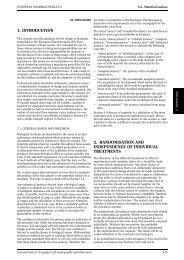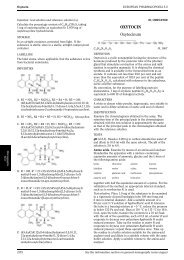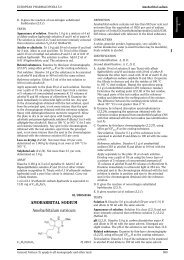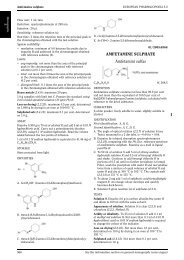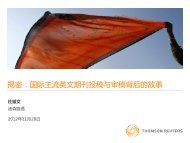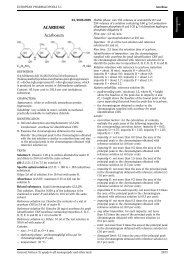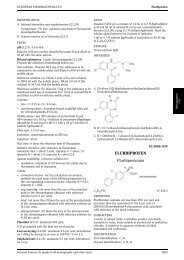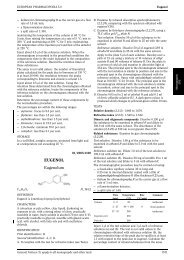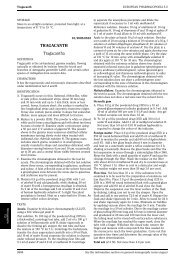EXTRACTS Extracta
EXTRACTS Extracta
EXTRACTS Extracta
Create successful ePaper yourself
Turn your PDF publications into a flip-book with our unique Google optimized e-Paper software.
Extracts EUROPEAN PHARMACOPOEIA 5.0<br />
Where possible, the biological potency of the IHRP is<br />
established by in vivo techniques such as skin testing,<br />
and expressed in units of biological activity. If not, for<br />
certain extracts, potency may be established by suitable<br />
immunoassays (for example, those based on the inhibition<br />
of the binding capacity of specific immunoglobulin E<br />
antibodies) or by quantitative techniques for a single major<br />
component.<br />
IDENTIFICATION<br />
Identity is confirmed at the intermediate or other applicable<br />
stage by comparison with the IHRP using protein profiling<br />
by appropriate methods (for example, isoelectric focusing,<br />
sodium dodecyl sulphate-polyacrylamide gel electrophoresis<br />
or immunoelectrophoresis).<br />
TESTS<br />
Various biochemical and immunological tests have been<br />
developed in order to characterise allergens qualitatively<br />
and quantitatively. However, some of the methods,<br />
particularly for the determination of allergenic activity<br />
and allergen profile, are not applicable to all products<br />
at present. This is because knowledge of the allergenic<br />
components or the required reagents is not available.<br />
Accordingly, allergen products have been classified in<br />
different categories with increasing test requirements,<br />
accordingtoqualityandintendeduse.<br />
Wherepossiblethefollowingtestsareappliedtothe<br />
final preparations. If not, they must be performed on the<br />
extracts as late as possible in the manufacturing process,<br />
for example, at the stage immediately prior to that stage<br />
(modification, dilution etc.) which renders the test not<br />
feasible on the final preparation.<br />
Water (2.5.12).Notmorethan5percentforfreeze-dried<br />
products.<br />
Sterility (2.6.1). Allergen products intended for parenteral,<br />
bronchial and conjunctival administration comply with the<br />
test for sterility.<br />
Protein content: 80percentto120percentofthestated<br />
content of a given batch. If the biological potency can be<br />
determined then the test for protein content may be omitted.<br />
Protein profile. The protein composition determined by<br />
suitable methods corresponds to that of the IHRP.<br />
Abnormal toxicity (2.6.9). Allergen products obtained from<br />
moulds and intended for parenteral administration (except<br />
skin-prick tests) comply with the test for abnormal toxicity<br />
for immunosera and vaccines for human use.<br />
Various additional tests, somewith increasing selectivity,<br />
depending on the allergen product concerned can be<br />
applied, but in any case for allergen products intended for<br />
therapeutic use a validated test measuring the potency<br />
(total allergenic activity, determination of individual<br />
allergens or any other justified tests) must be applied.<br />
Aluminium (2.5.13). Not less than 80 per cent and not more<br />
than 120 per cent of the stated amount but in any case<br />
notmorethan1.25mgperhumandoseunlessotherwise<br />
justified and authorised, when aluminium hydroxide or<br />
aluminium phosphate is used as adsorbent.<br />
Calcium (2.5.14). Not less than 80 per cent and not more<br />
than 120 per cent of the stated amount when calcium<br />
phosphateisusedasadsorbent.<br />
Antigen profile. The antigens are identified by means of<br />
suitable techniques using antigen-specific animal antibodies.<br />
Allergen profile. Relevant allergenic components<br />
are identified by means of suitable techniques using<br />
allergen-specific human antibodies.<br />
Total allergenic activity. The activity is 50 per cent to<br />
200 per cent of the stated amount as assayed by inhibition of<br />
the binding capacity of specific immunoglobulin E antibodies<br />
or a suitable equivalent in vitro method.<br />
Individual allergens: 50 per cent to 200 per cent of the<br />
stated amount, determined by a suitable method.<br />
STORAGE<br />
Adsorbed allergen products should not be frozen.<br />
LABELLING<br />
The label states:<br />
— the biological potency and/or the protein content and/or<br />
the extraction concentration;<br />
— the route of administration and the intended use;<br />
— the storage conditions;<br />
— where applicable, the name and amount of added<br />
antimicrobial preservative;<br />
— for freeze-dried preparations:<br />
— the name, composition and volume of the<br />
reconstituting liquid to be added<br />
— the period of time within which the preparation is to<br />
be used after reconstitution;<br />
— where applicable, that the preparation is sterile;<br />
— where applicable the name and amount of adsorbent.<br />
<strong>EXTRACTS</strong><br />
<strong>Extracta</strong><br />
01/2005:0765<br />
DEFINITION<br />
Extracts are preparations of liquid (liquid extracts and<br />
tinctures), semi-solid (soft extracts) or solid (dry extracts)<br />
consistency, obtained from herbal drugs or animal matters,<br />
which are usually in a dry state.<br />
Different types of extract may be distinguished. Standardised<br />
extracts are adjusted within an acceptable tolerance to<br />
a given content of constituents with known therapeutic<br />
activity; standardisation is achieved by adjustment of<br />
the extract with inert material or by blending batches of<br />
extracts. Quantified extracts are adjusted to a defined range<br />
of constituents; adjustments are made by blending batches<br />
of extracts. Other extracts are essentially defined by their<br />
production process (state of the herbal drug or animal<br />
matter to be extracted, solvent, extraction conditions) and<br />
their specifications.<br />
PRODUCTION<br />
Extracts are prepared by suitable methods using ethanol or<br />
other suitable solvents. Different batches of the herbal drug<br />
or animal matter may be blended prior to extraction. The<br />
herbal drug or animal matter to be extracted may undergo a<br />
preliminary treatment, for example, inactivation of enzymes,<br />
grinding or defatting. In addition, unwanted matter may be<br />
removed after extraction.<br />
Herbal drugs, animal matters and organic solvents used<br />
for the preparation of extracts comply with any relevant<br />
monograph of the Pharmacopoeia. For soft and dry extracts<br />
where the organic solvent is removed by evaporation,<br />
recoveredorrecycledsolventmaybeused,providedthatthe<br />
recovery procedures are controlled and monitored to ensure<br />
that solvents meet appropriate standards before re-use or<br />
admixture with other approved materials. Water used for<br />
the preparation of extracts is of suitable quality. Except<br />
for the test for bacterial endotoxins, water complying with<br />
570 See the information section on general monographs (cover pages)
EUROPEAN PHARMACOPOEIA 5.0 Extracts<br />
the section on Purified water in bulk of the monograph on<br />
Purified water (0008) is suitable. Potable water may be<br />
suitable if it complies with a defined specification that allows<br />
the consistent production of a suitable extract.<br />
Where applicable, concentration to the intended consistency<br />
is carried out using suitable methods, usually under reduced<br />
pressure, and at a temperature at which deterioration of the<br />
constituents is reduced to a minimum. Essential oils that<br />
have been separated during processing may be restored to<br />
the extracts at an appropriate stage in the manufacturing<br />
process. Suitable excipients may be added at the various<br />
stages of the manufacturing process for example to improve<br />
technological qualities such as homogeneity or consistency.<br />
Suitable stabilisers and antimicrobial preservatives may also<br />
be added.<br />
Extraction with a given solvent leads to typical proportions<br />
of characterised constituents in the extractable matter;<br />
during production of standardised and quantified extracts,<br />
purification procedures may be applied that increase these<br />
proportions with respect to the expected values; such<br />
extracts are referred to as “refined”.<br />
IDENTIFICATION<br />
Extracts are identified using a suitable method.<br />
TESTS<br />
Where applicable, as a result of analysis of the herbal drug<br />
or animal matter used for production and in view of the<br />
production process, tests for microbiological quality (5.1.4),<br />
heavy metals, aflatoxins, pesticide residues (2.8.13) inthe<br />
extracts may be necessary.<br />
ASSAY<br />
Wherever possible, extracts are assayed by a suitable method.<br />
LABELLING<br />
The label states:<br />
— the herbal drug or animal matter used,<br />
— whether the extract is liquid, soft or dry, or whether it<br />
is a tincture,<br />
— for standardised extracts, the content of constituents with<br />
known therapeutic activity,<br />
— for quantified extracts, the content of constituents<br />
(markers) used for quantification,<br />
— the ratio of the starting material to the genuine extract<br />
(DER),<br />
— the solvent or solvents used for extraction,<br />
— where applicable, that a fresh herbal drug or fresh animal<br />
matter has been used,<br />
— where applicable, that the extract is “refined”,<br />
— the name and amount of any excipient used including<br />
stabilisers and antimicrobial preservatives,<br />
— where applicable, the percentage of dry residue.<br />
Liquid extracts — extracta fluida<br />
DEFINITION<br />
Liquid extracts are liquid preparations of which, in general,<br />
1 part by mass or volume is equivalent to 1 part by mass of the<br />
dried herbal drug or animal matter. These preparations are<br />
adjusted, if necessary, so that they satisfy the requirements<br />
for content of solvent, and, where applicable, for constituents.<br />
PRODUCTION<br />
Liquid extracts are prepared by using ethanol of suitable<br />
concentration or water to extract the herbal drug or animal<br />
matter, or by dissolving a soft or dry extract (which has been<br />
produced using the same strength of extraction solvent as<br />
is used in preparing the liquid extract by direct extraction)<br />
of the herbal drug or animal matter in either ethanol of<br />
suitable concentration or water. Liquid extracts may be<br />
filtered, if necessary.<br />
Aslightsedimentmayformonstanding,whichisacceptable<br />
as long as the composition of the liquid extract is not<br />
changed significantly.<br />
TESTS<br />
Relative density (2.2.5). Where applicable, the liquid extract<br />
complies with the limits prescribed in the monograph.<br />
Ethanol (2.9.10). For alcoholic liquid extracts, carry out<br />
the determination of ethanol content. The ethanol content<br />
complies with that prescribed.<br />
Methanol and 2-propanol (2.9.11): maximum 0.05 per<br />
cent V/V of methanol and maximum 0.05 per cent V/V of<br />
2-propanol for alcoholic liquid extracts unless otherwise<br />
prescribed.<br />
Dry residue (2.8.16). Where applicable, the liquid extract<br />
complies with the limits prescribed in the monograph,<br />
corrected if necessary, taking into account any excipient<br />
used.<br />
STORAGE<br />
Protected from light.<br />
LABELLING<br />
The label states in addition to the requirements listed above:<br />
— where applicable, the ethanol content in per cent V/V in<br />
the final extract.<br />
Tinctures — tincturae<br />
DEFINITION<br />
Tinctures are liquid preparations which are usually obtained<br />
using either 1 part of herbal drug or animal matter and<br />
10 parts of extraction solvent or 1 part of herbal drug or<br />
animal matter and 5 parts of extraction solvent.<br />
PRODUCTION<br />
Tinctures are prepared by maceration or percolation (outline<br />
methodology is given below) using only ethanol of a suitable<br />
concentration for extraction of the herbal drug or animal<br />
matter, or by dissolving a soft or dry extract (which has been<br />
produced using the same strength of extraction solvent as<br />
is used in preparing the tincture by direct extraction) of<br />
the herbal drug or animal matter in ethanol of a suitable<br />
concentration. Tinctures are filtered, if necessary.<br />
Tinctures are usually clear. A slight sediment may form on<br />
standing which is acceptable as long as the composition of<br />
the tincture is not changed significantly.<br />
Production by maceration. Unless otherwise prescribed,<br />
reduce the herbal drug or animal matter to be extracted to<br />
pieces of suitable size, mix thoroughly with the prescribed<br />
extraction solvent and allow to stand in a closed container<br />
for an appropriate time. The residue is separated from the<br />
extraction solvent and, if necessary, pressed out. In the latter<br />
case, the 2 liquids obtained are combined.<br />
Production by percolation. If necessary, reduce the herbal<br />
drug or animal matter to be extracted to pieces of suitable<br />
size. Mix thoroughly with a portion of the prescribed<br />
extraction solvent and allow to stand for an appropriate time.<br />
Transfer to a percolator and allow the percolate to flow at<br />
room temperature slowly making sure that the herbal drug<br />
GeneralNotices(1)applytoallmonographsandothertexts 571
Herbal drug preparations EUROPEAN PHARMACOPOEIA 5.0<br />
or animal matter to be extracted is always covered with the<br />
remaining extraction solvent. The residue may be pressed<br />
outandtheexpressedliquidcombinedwiththepercolate.<br />
TESTS<br />
Relative density (2.2.5). Where applicable, the tincture<br />
complies with the limits prescribed in the monograph.<br />
Ethanol (2.9.10). The ethanol content complies with that<br />
prescribed.<br />
Methanol and 2-propanol (2.9.11): maximum0.05per cent V/V of methanol and maximum 0.05 per cent V/V of<br />
2-propanol, unless otherwise prescribed.<br />
Dry residue (2.8.16).Whereapplicable,thetincturecomplies<br />
with the limits prescribed in the monograph, corrected if<br />
necessary, taking into account any excipient used.<br />
STORAGE<br />
Protected from light.<br />
LABELLING<br />
The label states in addition to the requirements listed above:<br />
— for tinctures other than standardised and quantified<br />
tinctures, the ratio of starting material to extraction liquid<br />
or of starting material to final tincture,<br />
— the ethanol content in per cent V/V in the final tincture.<br />
Soft extracts — extracta spissa<br />
DEFINITION<br />
Soft extracts are semi-solid preparations obtained by<br />
evaporation or partial evaporation of the solvent used for<br />
extraction.<br />
TESTS<br />
Dry residue (2.8.16). The soft extract complies with the<br />
limits prescribed in the monograph.<br />
Solvents. Where applicable, a monograph on a soft extract<br />
prescribes a limit test for the solvent used for extraction.<br />
STORAGE<br />
Protected from light.<br />
Dry extracts — extracta sicca<br />
DEFINITION<br />
Dry extracts are solid preparations obtained by evaporation<br />
of the solvent used for their production. Dry extracts usually<br />
havealossondryingorawatercontentofnotgreaterthan<br />
5percentm/m.<br />
TESTS<br />
Water (2.2.13). Where applicable, the dry extract complies<br />
with the limits prescribed in the monograph.<br />
Loss on drying (2.8.17). Where applicable, the dry extract<br />
complies with the limits prescribed in the monograph.<br />
Solvents. Where applicable, a monograph on a dry extract<br />
prescribes a limit test for the solvent used for extraction.<br />
STORAGE<br />
In an airtight container, protected from light.<br />
01/2005:1434<br />
HERBAL DRUG PREPARATIONS<br />
Plantae medicinales praeparatore<br />
DEFINITION<br />
Herbal drug preparations are obtained by subjecting<br />
herbaldrugstotreatmentssuchasextraction,distillation,<br />
expression, fractionation, purification, concentration or<br />
fermentation. These include comminuted or powdered<br />
herbal drugs, tinctures, extracts, essential oils, expressed<br />
juices and processed exudates.<br />
Herbal teas comply with the monograph on Herbal<br />
teas (1435).<br />
Instant herbal teas consist of powder or granules of one or<br />
more herbal drug preparation(s) intended for the preparation<br />
of an oral solution immediately before use.<br />
HERBAL DRUGS<br />
Plantae medicinales<br />
01/2005:1433<br />
DEFINITION<br />
Herbal drugs are mainly whole, fragmented or cut, plants,<br />
parts of plants, algae, fungi, lichen in an unprocessed state,<br />
usually in dried form but sometimes fresh. Certain exudates<br />
that have not been subjected to a specific treatment are also<br />
considered to be herbal drugs. Herbal drugs are precisely<br />
defined by the botanical scientific name according to the<br />
binominal system (genus, species, variety and author).<br />
PRODUCTION<br />
Herbal drugs are obtained from cultivated or wild plants.<br />
Suitable collection, cultivation, harvesting, drying,<br />
fragmentation and storage conditions are essential to<br />
guarantee the quality of herbal drugs.<br />
Herbal drugs are, as far as possible, free from impurities such<br />
as soil, dust, dirt and other contaminants such as fungal,<br />
insect and other animal contaminations. They are not rotten.<br />
If a decontaminating treatment has been used, it is necessary<br />
to demonstrate that the constituents of the plant are not<br />
affected and that no harmful residues remain. The use of<br />
ethylene oxide is prohibited for the decontamination of<br />
herbal drugs.<br />
IDENTIFICATION<br />
Herbal drugs are identified using their macroscopic and<br />
microscopic descriptions and any further tests that may be<br />
required (for example, thin-layer chromatography).<br />
TESTS<br />
Atestforforeignmatter(2.8.2) iscarriedout,unless<br />
otherwise prescribed in the individual monographs.<br />
A specific appropriate test may apply to herbal drugs liable<br />
to be falsified.<br />
If appropriate, the herbal drugs comply with other tests, for<br />
example, total ash (2.4.16), ash insoluble in hydrochloric<br />
acid (2.8.1), extractable matter, swelling index (2.8.4) and<br />
bitterness value.<br />
The test for loss on drying (2.2.32) iscarriedouton<br />
herbal drugs, unless otherwise prescribed in the individual<br />
monographs. A determination of water (2.2.13) iscarried<br />
out for herbal drugs with a high essential oil content.<br />
572 See the information section on general monographs (cover pages)



